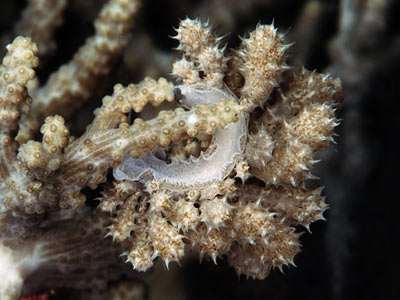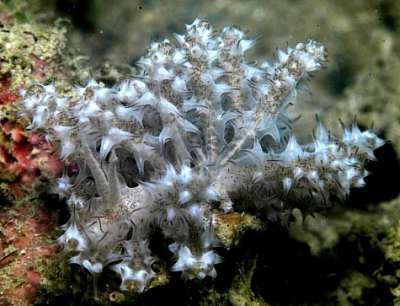

Phyllodesmium koehleri
Burghardt, Schroedl & Wagele, 2008
Order: NUDIBRANCHIA
Superfamily: AEOLIDINA
Family: Glaucidae
DISTRIBUTION
Known from southern Queensland, Australia (Cobb, 2004); Okinawa, Japan (Bolland, 2005); Sulawesi, Indonesia (Sozzani, 2004) and New Britain, Papua New Guinea (Barrett & Barrett, 2004), Philippines (Koehler, 2008).
PHOTO
Upper: Manado, North Sulawesi, Indonesia. Depth: 12 m., Length 2-3 cm. Photo: Roberto Sozzani. Lower: Lindenhaven Bay, New Britain, Papua New Guinea. 7 meters depth. January, 2004. Photo: John & Debra Barrett.
The body, including oral tentacles, rhinophores, foot and cerata, is transparent to translucent clear, with some white dusting. Thin brown streaks and patches, caused by zooxanthellae in small branches of the digestive gland, are scattered all over. Animals elongate, up to approximately 56 mm in length. The rhinophores and slightly shorter oral tentacles are smooth and tapering. The anal papilla is prominent and situated dorso-laterally just behind the second ceratal cluster on the right side. The cerata are arranged in groups and it seems the first cluster on each side is an arch, while the rest are in sloping rows on each side. The cerata are club-shaped, relatively thin at the base but expanding to a much greater diameter near the tip. Each ceras has many large pointed tubercles radiating out laterally. Each tubercle has a brownish duct of the digestive gland running out to the tip. Zooxanthellae are present in the cells and lumen of the digestive gland ducts. The jaw plates and radular teeth are similar in shape to those of P. jakobsenae [see #14684]
Phyllodesmium koehleri differs from all other described Phyllodesmium species in its choice of food. From available information on the Forum it seems to specialize on members of the Nephtheidae, probably Paralemnalia or Lemnalia [Sozzani, 2004 see #12313 - identification by P. Alderslade]. The unique spiny cerata of P. koehleri mimic parts of these soft corals and distinguish it from other species. Unlike xeniid feeding species, the cerata are never curled in the upper part, and like other non-xeniid feeders it has branches of the digestive gland within the body wall.
- Burghardt, I., Schroedl, M. & Wagele, H. 2008. Three new solar-powered species of the genus Phyllodesmium Ehrenberg, 1831 (Mollusca: Nudibranchia: Aeolidioidea) from the tropical Indo-pacific, with analysis of their photosynthetic activity and notes on biology. Journal of Molluscan Studies, 74: 277-292.
Rudman, W.B., 2008 (August 29) Phyllodesmium koehleri Burghardt, Schroedl & Wagele, 2008. [In] Sea Slug Forum. Australian Museum, Sydney. Available from http://www.seaslugforum.net/factsheet/phylkoeh
Related messages
-
Phyllodesmium koehleri on possible food
From: Erwin Koehler, September 8, 2008 -
Phyllodesmium koehleri from southern Queensland
From: Gary Cobb, September 1, 2008 -
Phyllodesmium koehleri from Sabah, Borneo
From: Richard Swann, September 1, 2008 -
Phyllodesmium koehleri from the Philippines
From: Erwin Koehler, September 1, 2008 -
Three new species of Phyllodesmium.
From: Bill Rudman, September 1, 2008 -
Phyllodesmium sp. 2 from Indonesia
From: Roberto Sozzani, February 27, 2004 -
Phyllodesmium sp 2 from New Britain
From: John & Debra Barrett, February 25, 2004 -
Phyllodesmium sp. on food
From: Atsushi Ono, May 30, 2000 -
Phyllodesmium spp from Okinawa
From: Bob Bolland, August 4, 1998
